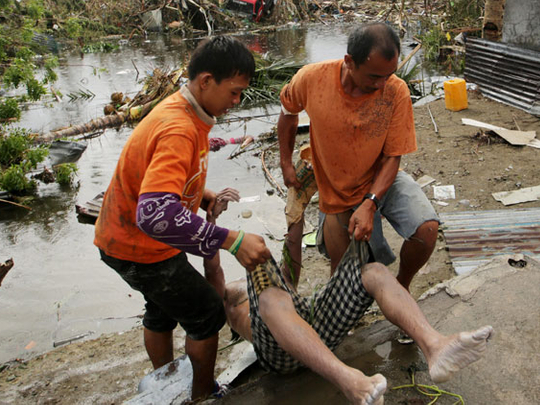
Manila: Philippine government agencies have come under fire for the waste and mishandling of P1.401 billion (Dh116.75 million) worth of goods and money meant for victims of Typhoon Haiyan.
Despite donations from the international community, tonnes of relief goods were spoilt and large sums of money lay idle after Typhoon Haiyan, a four-grade storm that killed almost 7,000 people, affected 15 million and left six million jobless in central Philippines last November 2013, a national audit report says.
This could mean that the government suffered from “poor disaster response system (after Typhoon Haiyan occurred in central and eastern Visayas),” said the Commission on Audit in its 2013 year-end report, which was released this month.
The greater part of the losses, P1.399 billion, involved government agencies such as the departments of health, social welfare and development, and public works — which should have used the funds and goofs for the typhoon survivors a month after the calamity intensified in affected areas in the Visayas, said the COA report.
It said the amount included P700 million from local donors and $15 million (Dh58.25 million) more from foreign countries.
Concerned agencies failed to coordinate and agree on how to spend the monetary donations for the sake of the typhoon survivors, said the COA report.
At the same time, there were no daily and periodic accounting of funds that were received and utilised as of end of December 2013, COA complained, adding that concerned agencies “failed to promote accountability and transparency in handling monetary donations”.
The losses also included P2.7 million worth of family food packs, which were found rotting in warehouses by end of 2013, COA said, adding the spoilage occurred just a month after Typhoon Haiyan hit central and eastern Visayas.
Also found damaged were 95,472 assorted canned goods; 81 packs of noodles; and, 21 sacks of rice, COA said , without disclosing the monetary value of the items.
The department of social welfare and development established the National Relief Operations centre, but it was a “logistical nightmare because of (a general) lack of storage facilities for the repacking of donated and procured relief goods, lack of delivery trucks, and the absence of alternate transport system that could have paved the way for prompt delivery of relief goods to all survivors in isolated and damaged places,” said the report.
At the same time, the social and welfare department failed to give full accounting of spoiled food supplies, including dented canned goods that were disposed of, the COA said , adding there was also no daily or periodic accounting of the status of delivery of relief goods to typhoon victims.
In response, Social Welfare and Development Secretary Corazon “Dinky” Soliman said that accounting of damaged and spoiled food products, including the status of delivery of relief goods to typhoon survivors, is a continuing process.
“There was no massive spoilage of relief goods,” Soliman said.
She howeveradmitted though that the absence of transportation and warehousing facilities greatly contributed to the spoilage of relief goods.
She denied earlier reports that the government hired people to gather truckloads of spoiled food products that were buried in an open dumpsite in Palo town, Leyte.
Some 20 typhoons devastate the Philippines every year. It is part of Asia Pacific’s “Ring of Fire” where volcanic eruptions and earthquake always occur.











